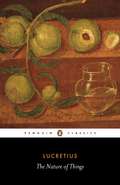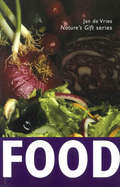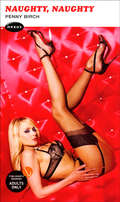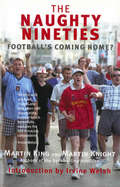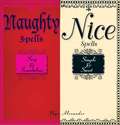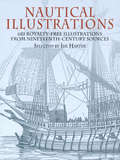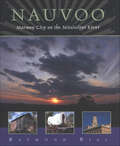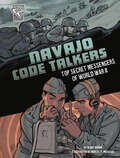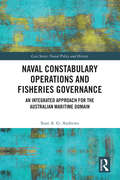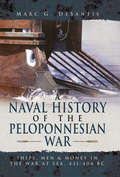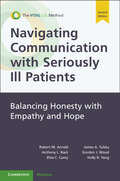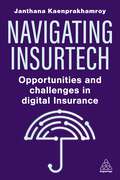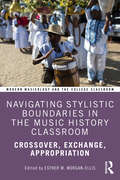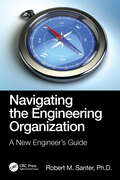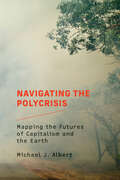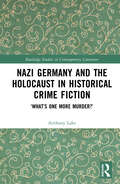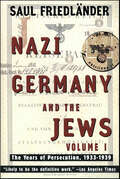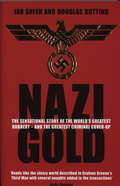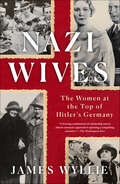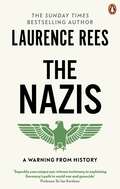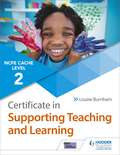- Table View
- List View
The Nature of Things
by LucretiusLucretius' poem On the Nature of Things combines a scientific and philosophical treatise with some of the greatest poetry ever written. With intense moral fervour he demonstrates to humanity that in death there is nothing to fear since the soul is mortal, and the world and everything in it is governed by the mechanical laws of nature and not by gods; and that by believing this men can live in peace of mind and happiness. He bases this on the atomic theory expounded by the Greek philosopher Epicurus, and continues with an examination of sensation, sex, cosmology, meteorology, and geology, all of these subjects made more attractive by the poetry with which he illustrates them.
Nature's Gift of Food
by Jan de VriesYour food is your medicine and your medicine your food. So said Hippocrates, the father of medicine - but nothing could sum up Jan de Vries' approach to dietary management better. Over the past 35 years the number of people seeking his advice on food-related problems has increased dramatically, for although there are numerous books available on the subject, the information they contain is often contradictory and confusing - not surprisingly, maybe, when there are over 4,000 addictives finding their way into our food everyday. But wholesome eating is, in fact, very simple and you only need the sensible guidance contained in this book. The results speak for themselves. A balanced diet produces a noticeable increase in energy levels fairl quickly. Nutrition is a subject close to Jan de Vries' heart and his enthusiasm is evident in this latest book. Easy to read and easy to follow, it is a dietary plan for every household.
Naughty Naughty
by Penny BirchGabrielle Salinger has been sent to track down Sabrina, a voluptuous and dominant young woman who has fallen under the influence of elderly sybarite David Anthony. Gabrielle soon discovers that the couple are already in France, getting up to all sorts of lewd mischief. Accompanied, but not really helped, by her girlfriend Poppy, Monty Hartle and the boys from the Razorback Paintball, Gabrielle is soon beginning to wonder if she's bitten off more that she can chew. By the time she's being hunted through the woods in bunny costume, she's sure that she has.
The Naughty Nineties: Football's Coming Home
by Martin King Martin KnightFootball has reinvented itself. As television money has poured into the game, the traditional working-class fans have poured out - not by choice, but by economic necessity. According to those in charge of the game the football hooligan has at last been eliminated from the landscape. But how true is this much-vaunted claim? Martin King, author of Hoolifan, brings his story up to date in The Naughty Nineties. Ironically, he finds that football hooligans now really are in the minority but they are far more dangerous and committed than ever before.
Naughty Spells and Nice Spells: Sexy & Scandalous; Simple & Sweet
by Skye AlexanderNaughty Spells/Nice Spells is a genuinely unique offering in this time-honored category. Tailored for readers' naughty sides and nice sides, both halves of this adorable volume feature a collection of simple, effective spells and charms anyone can whip up at home in no time.Plus!Naughty Spells/Nice Spells boasts a unique spell rating that helps readers determine just how naughty - or nice - they'd like to be:Silver spell = niceFog spell = mischievousSmoky spell = slightly naughtyNimbus spell = naughtyFilled with all-occasion spells for love, prosperity, and happiness, Naughty Spells/Nice Spells is the perfect book for anyone looking to bring more love, luck, and magick into their lives.
Nautical Illustrations: 681 Royalty-Free Illustrations from Nineteenth-Century Sources (Dover Pictorial Archive)
by Jim HarterWhile this book is intended is intended for all who love boats, ships, history, and nautical lore, it is also designed as a definitive source of high-quality, royalty-free images for use by artists, graphic designers, desktop publishers, ad agencies, and more. This collection of 681 wood engravings includes striking examples of some of the world's most beautiful boats and ships. Among the many famous vessels in this volume are Columbus's ships, the Nina, Pinta, and Santa Maria; King Henry's VIII's Great Harry; the Pilgrim Fathers' Mayflower; Henry Hudson's Half Moon; King Charles I's Sovereign of the Seas; Captain Cook's Discovery; the HMS Bellerophon; Fulton's Clermont; and the Great Eastern. Among famous naval battles shown are the conflict at Actium, the invasion of the Spanish Armada, Dutch-English engagements in the 17th century, Anson's Centurion capturing a Spanish treasure ship, Nelson's victory at Trafalgar, Perry's triumph at Lake Erie, and the Civil War ironclad contest between the Monitor and the Merrimac. This volume includes a wide variety of vessels: rowboats, funeral barges, Venetian gondolas, catamarans, Native American canoes, Chinese junks, tugboats, canal boats, barges, yachts, brigs, barks, sloops, skiffs, catboats, various kinds of vessels used for fishing and whaling, ships in distress, and more. There are also examples of nautically related material: navigational instruments, diving suits and helmets, lighthouses, canal locks, dry docks, the Suez Canal, helmsmen, ship captains, seamen at work, deck scenes, and interiors of boats. taken from rare sources — depict primitive canoes, a Roman galley, ship figureheads, naval battles, dock scenes, lighthouses, pirate ships, steam-powered battleships, and a wealth of other subjects. Brief captions identify pictures, which are arranged chronologically. Features over 600 black-and-white illustrations from rare sources, arranged chronologically.
Nauvoo: Mormon City on the Mississippi River
by Raymond BialIn 1839, persecuted Mormons fled Missouri, across the Mississippi River, seeking freedom from violence. They hoped to find a safe haven on the banks of the river in an Illinois city that they called Nauvoo, “the city beautiful.”The Mormons did not flourish for long in Nauvoo. In neighboring cities some grew resentful of the prosperity that Joseph Smith and his people were enjoying. Religious misconceptions further fueled hostility toward the Mormons. Would the oft-persecuted Mormons have to flee their city beautiful?Through poignant writing and photographs of Nauvoo today, Raymond Bial tells the story of the city that many Mormons consider to be the wellspring of their religion.
Navajo Code Talkers: Top Secret Messengers Of World War Ii (Amazing World War Ii Stories Ser.)
by Blake HoenaDuring World War II U.S. forces had to keep battle plans and other top secret information out of the enemy's hands. Coded messages were often used, but secret codes could be broken. To solve this problem, the U.S. military turned to an unexpected source to create an unbreakable code. The Navajo people spoke a complex language that few outsiders knew how to speak. Several Navajo soldiers were recruited to develop a code based on the Navajo language. The result was a complex code that could not be solved by the enemy. Learn all about the brave Navajo Code Talkers and how their unbreakable code helped defeat the enemy and win the war.
Naval Constabulary Operations and Fisheries Governance: An Integrated Approach for the Australian Maritime Domain (ISSN)
by Sean A. AndrewsThis book offers an analysis of naval constabulary operations, in particular Australian fisheries patrols, and challenges the widely accepted Anglo-American school of maritime thought.In the Indo-Pacific, fisheries and the activities of fishing boats are of increasing strategic importance in Australia’s region – Australia’s Four Oceans. Issues of overfishing, population growth and climate change are placing growing pressure on fish as a resource, and in doing so are making fisheries more significant, and significant on a strategic as opposed to simply an economic or environmental level. When, combined with the growing use of fishing vessels as para-naval forces, it is clear that the activities of fishing vessels, whether fishing or not fishing, are matters of considerable strategic relevance. This book illuminates contemporary seapower challenges, explains and defines maritime security and examines and refines existing theory to advance a set of new or refined concepts to help frame the on-water activities of constabulary operations -- reducing the possibility of on-water miscalculation between states.This book will be of much interest to students and scholars of naval studies and sea power, maritime strategy, maritime security and International Relations.
A Naval History of the Peloponnesian War: Ships, Men and Money in the War at Sea, 431-404 BC
by Marc G. de SantisNaval power played a vital role in the Peloponnesian War. The conflict pitted Athens against a powerful coalition including the preeminent land power of the day, Sparta. Only Athens superior fleet, her wooden walls, by protecting her vital supply routes allowed her to survive. It also allowed the strategic freedom of movement to strike back where she chose, most famously at Sphacteria, where a Spartan force was cut off and forced to surrender.Athens initial tactical superiority was demonstrated at the Battle of Chalcis, where her ships literally ran rings round the opposition but this gap closed as her enemies adapted. The great amphibious expedition to Sicily was a watershed, a strategic blunder compounded by tactical errors which brought defeat and irreplaceable losses. Although Athens continued to win victories at sea, at Arginusae for example, her naval strength had been severely weakened while the Spartans built up their fleets with Persian subsidies. It was another naval defeat, at Aegispotomi (405 BC) that finally sealed Athens fate. Marc De Santis narrates these stirring events while analyzing the technical, tactical and strategic aspects of the war at sea.
Naval Science 3: Naval Knowledge, Leadership, And Nautical Skills For The Njrotc Student
by Richard R. HobbsNaval Science, Volume 3
Navigating Communication with Seriously Ill Patients: Balancing Honesty with Empathy and Hope
by null Robert M. Arnold null Anthony L. Back null Elise C. Carey null James A. Tulsky null Gordon J. Wood null Holly B. YangWhen clinicians communicate effectively, patients retain more information, have higher trust and a better quality of life. Such a patient-centred approach is the future of clinical care, and this book is an essential how-to guide on improving these skills. Grounded in innovative and evidence-based methodology, perfected through over twenty years of teaching in the VitalTalk training program, content includes foundational communication skills, how to help patients plan for the future, what to do when you are really stuck, and strategies to work through conflicts with colleagues. In this updated edition, emphasis is placed on the roles privilege, race, and power play in the medical encounter, and new tools are provided to help clinicians navigate this landscape with greater self-awareness and sensitivity. This practical guide is filled with skills and roadmaps, demonstrating how to be clearer when sharing information, more competent at understanding patient concerns, and more effective when making recommendations.
Navigating Insurtech: Opportunities and Challenges in Digital Insurance
by Janthana KaenprakhamroyNavigating Insurtech demystifies the insurtech ecosystem, providing insurance professionals with a comprehensive understanding of the industry and its key players, components, challenges and opportunities. The insurtech landscape is highly complex and constantly evolving, making it difficult to fully understand its opportunities and challenges. Yet insurance companies that fail to evolve and grasp advancements in insurtech could risk losing market share and suffer reputational damage. This book offers practical guidance for insurance companies looking to implement insurtech solutions, supported throughout by real-life case studies, insights and interviews from industry leaders and experts. It examines key developments, such as customer experience, risk management, distribution channels and transformative technologies such as blockchain, IoT and AI. It also looks at the investment landscape, offering insights into successful insurtech investments, opportunities and challenges of investing in insurtech startups.To succeed in insurtech, organizations must have a deep understanding of the industry and the technologies involved, as well as the ability to build strong partnerships with other players in the ecosystem. Navigating Insurtech is an essential read for insurance and insurtech professionals, investors and anyone else interested in the developments of insurtech.
Navigating Stylistic Boundaries in the Music History Classroom: Crossover, Exchange, Appropriation (Modern Musicology and the College Classroom)
by Esther M. Morgan-EllisAt a time of transformation in the music history classroom and amid increasing calls to teach a global music history, Navigating Stylistic Boundaries in the Music History Classroom adds nuance to the teaching of varied musical traditions by examining the places where they intersect and the issues of musical exchange and appropriation that these intersections raise. Troubling traditional boundaries of genre and style, this collection of essays helps instructors to denaturalize the framework of Western art music and invite students to engage with other traditions—vernacular, popular, and non-Western—on their own terms.The book draws together contributions by a wide range of active scholars and educators to investigate the teaching of music history around cases of stylistic borders, exploring the places where different practices of music and values intersect. Each chapter in this collection considers a specific case in which an artist or community engages in what might be termed musical crossover, exchange, or appropriation and delves deeper into these concepts to explore questions of how musical meaning changes in moving across worlds of practice. Addressing works that are already widely taught but presenting new ways to understand and interpret them, this volume enables instructors to enrich the perspectives on music history that they present and to take on the challenge of teaching a more global music history without flattening the differences between traditions.
Navigating the Engineering Organization: A New Engineer's Guide
by Robert M. SanterTransitioning new engineers into professionals who can blend in and contribute to the technical organization is, at best, doubtful. Trained in the "nuts and bolts" of a technical subject, new engineers have little to no training on the "soft" skills of how to work within an organization. This robust guide shows new engineers how to quickly operate and succeed within their new engineering organization.Navigating the Engineering Organization: A New Engineer’s Guidefocuses on the group behaviors of technical organizations. It provides a rigorous organizational framework to operate from and delivers guidance using a dual approach of academic insight and professional experience. Through numerous case studies, the book presents actual experiential guidance and offers a method on how to extend the insights covered in the book and turn them into a valuable personal model, valid throughout the engineer’s career. It helps readers understand quickly the unique values and expectations within their new engineering organization and guides them in discovering the proper ways to respond to these expectations. They can then act on these insights to deliver successful results, now and throughout their careers.The approach and goals found in this book provide a building block to help all new engineers cross the "Great Divide" from student to professional and succeed in their new engineering organization.
Navigating the Evolving Landscape between China and Africa’s Economic Engagements (Imf Working Papers)
by RawlingsA report from the International Monetary Fund.
Navigating the Polycrisis: Mapping the Futures of Capitalism and the Earth
by Michael J. AlbertAn innovative work of realism and utopianism that analyzes the possible futures of the world-system and helps us imagine how we might transition beyond capitalism.The world-system of which we are all a part faces multiple calamities: climate change and mass extinction, the economic and existential threat of AI, the chilling rise of far-right populism, and the invasion of Ukraine, to name only a few. In Navigating the Polycrisis, Michael Albert seeks to illuminate how the &“planetary polycrisis&” will disrupt the global community in the coming decades and how we can best meet these challenges. Albert argues that we must devote more attention to the study of possible futures and adopt transdisciplinary approaches to do so. To provide a new form of critical futures analysis, he offers a theoretical framework—planetary systems thinking—that is informed by complexity theory, world-systems theory, and ecological Marxism. Navigating the Polycrisis builds on existing work on climate futures and the futures of capitalism and makes three main contributions. First, the book brings together modeling projections with critical social theory in a more systematic way than has been done so far. Second, the book shows that in order to grasp the complexity of the planetary polycrisis, we must analyze the convergence of crises encompassing the climate emergency, the structural crisis of global capitalism, net energy decline, food system disruption, pandemic risk, far-right populism, and emerging technological risks (e.g. in the domains of artificial intelligence, biotechnology, and nuclear weapons). And third, the book contributes to existing work on postcapitalist futures by analyzing the processes and mechanisms through which egalitarian transitions beyond capitalism might occur.A much-needed work of global futures studies, Navigating the Polycrisis brings together the rigor of the natural and social sciences and speculative imagination informed by science fiction to forge pathways to our possible global future.
Nazi Germany and the Holocaust in Historical Crime Fiction: ‘What’s One More Murder?’ (Routledge Studies in Contemporary Literature)
by Anthony LakeThis is the first book- length academic study of the portrayal in contemporary historical crime fiction of Nazi Germany and the Holocaust and their legacies. It discusses novels written by five authors: David Downing, Philip Kerr, Luke McCallin, Joseph Kanon and David Thomas. Their work belongs to a subgenre of the historical crime novel that has emerged since the late 1980s to become a significant body of writing located at the intersection of crime fiction and Holocaust literature. The readings of these novels explore questions of form and genre to ask how popular fiction might approach the Holocaust. Themes of resistance and complicity and the relationship between them, and problems of guilt and responsibility are also discussed. This book also explores questions of justice to show how these novels explore social and moral justice, and vengeance and revenge, as alternatives to ordinary legal justice after the Holocaust.
Nazi Germany and the Jews, 1933–1945: Abridged Edition
by Saul Friedländer Orna KenanNazi Germany and the Jews, 1933-1945 is an abridged edition of Saul Friedländer's definitive Pulitzer Prize-winning two-volume history of the Holocaust: Nazi Germany and the Jews: The Years of Persecution, 1933-1939 and The Years of Extermination: Nazi Germany and the Jews, 1939-1945.The book's first part, dealing with the National Socialist campaign of oppression, restores the voices of Jews who were engulfed in an increasingly horrifying reality following the Nazi accession to power. Friedländer also provides the accounts of the persecutors themselves—and, perhaps most telling of all, the testimonies of ordinary German citizens who, in general, stood silent and unmoved by the increasing waves of segregation, humiliation, impoverishment, and violence. The second part covers the German extermination policies that resulted in the murder of six million European Jews—an official program that depended upon the cooperation of local authorities and police departments, the passivity of the populations, and the willingness of the victims to submit in desperate hope of surviving long enough to escape the German vise.A monumental, multifaceted study now contained in a single volume, Saul Friedländer's Nazi Germany and the Jews, 1933-1945 is an essential study of a dark and complex history.
Nazi Germany and the Jews, Volume 1: The Years of Perdecution, 1933–1939
by Saul FriedländerA great historian crowns a lifetime of thought and research by answering a question that has haunted us for more than 50 years: How did one of the most industrially and culturally advanced nations in the world embark on and continue along the path leading to one of the most enormous criminal enterprises in history, the extermination of Europe's Jews? Giving considerable emphasis to a wealth of new archival findings, Saul Friedlander restores the voices of Jews who, after the 1933 Nazi accession to power, were engulfed in an increasingly horrifying reality. We hear from the persecutors themselves: the leaders of the Nazi party, the members of the Protestant and Catholic hierarchies, the university elites, and the heads of the business community. Most telling of all, perhaps, are the testimonies of ordinary German citizens, who in the main acquiesced to increasing waves of dismissals, segregation, humiliation, impoverishment, expulsion, and violence.
Nazi Gold: The Sensational Story of the World's Greatest Robbery – and the Greatest Criminal Cover-Up
by Douglas Botting IAN SAYERIn 1945, as Allied bombers continued their final pounding of Berlin, the panicking Nazis began moving the assets of the Reichsbank south for safekeeping. Vast trainloads of gold and currency were evacuated from the doomed capital of Hitler's 'Thousand-year Reich'. Nazi Gold is the real-life story of the theft of that fabulous treasure - worth some 2,500,000,000 at the time of the original investigation. It is also the story of a mystery and attempted whitewash in an American scandal that pre-dated Watergate by nearly 30 years. Investigators were impeded at every step as they struggled to uncover the truth and were left fearing for their lives. The authors' quest led them to a murky, dangerous post-war world of racketeering, corruption and gang warfare. Their brilliant reporting, matching eyewitness testimony with declassified Top Secret documents from the US Archives, lays bare this monumental crime in a narrative which throngs with SS desperadoes, a red-headed queen of crime and American military governors living like Kings. Also revealed is the authors' discovery of some of the missing treasure in the Bank of England.
Nazi Wives: The Women at the Top of Hitler's Germany
by James WyllieNazi Wives is a fascinating look at the personal lives, psychological profiles, and marriages of the wives of officers in Hitler's inner circle.Goering, Goebbels, Himmler, Heydrich, Hess, Bormann—names synonymous with power and influence in the Third Reich. Perhaps less familiar are Carin, Emmy, Magda, Margaret, Lina, Ilse and Gerda... These are the women behind the infamous men—complex individuals with distinctive personalities who were captivated by Hitler and whose everyday lives were governed by Nazi ideology. Throughout the rise and fall of Nazism these women loved and lost, raised families and quarreled with their husbands and each other, all the while jostling for position with the Fuhrer himself. Until now, they have been treated as minor characters, their significance ignored, as if they were unaware of their husbands' murderous acts, despite the evidence that was all around them: the stolen art on their walls, the slave labor in their homes, and the produce grown in concentration camps on their tables.James Wyllie's Nazi Wives explores these women in detail for the first time, skillfully interweaving their stories through years of struggle, power, decline and destruction into the post-war twilight of denial and delusion.
The Nazis: A Warning From History
by Laurence ReesFollowing the success of Rees' bestselling Auschwitz, this substantially revised and updated edition of The Nazis - A Warning from History tells the powerfully gripping story of the rise and fall of the Third Reich.During a 16-year period, acclaimed author and documentary-maker Laurence Rees met and interviewed a large number of former Nazis, and his unique insights into the Nazi psyche and World War 2 received enormous praise.At the heart of the book lies compelling eyewitness accounts of life under Adolf Hitler, spoken through the words of those who experienced the Nazi regime at every level of society. An extensive new section on the Nazi/Soviet war (previously published in Rees' War of the Century) provides a chilling insight into Nazi mentality during the most bloody conflict in history.Described as one of the greatest documentary series of all times The Nazis - A Warning from History won a host of awards, including a BAFTA and an International Documentary Award.
NCFE CACHE Level 2 Certificate in Supporting Teaching and Learning
by Louise BurnhamBe inspired to enhance classroom learning with this textbook, by highly respected and experienced author Louise Burnham.-Build your learning support skills with guidance tailored to the extensive new CACHE qualification due to launch in January 2018-Gain confidence in your role with practical advice and full explanations from best-selling author in STL , Louise Burnham -Translate theory into practice with Tips for Best Practice and Case Studies for challenging topics such as Behaviour Management-Strengthen your understanding of theory and practice, with comprehensive information linked clearly to assessment criteria-Find all the information you need with the colourful, clear design and appropriate language throughout the book -Make the most of your training with the Stretch and Challenge feature-Engage in debate on important STL topics with Classroom Discussion suggestions
NCFE CACHE Level 2 Certificate in Supporting Teaching and Learning
by Louise BurnhamBe inspired to enhance classroom learning with this textbook, by highly respected and experienced author Louise Burnham.-Build your learning support skills with guidance tailored to the extensive new CACHE qualification due to launch in January 2018-Gain confidence in your role with practical advice and full explanations from best-selling author in STL , Louise Burnham -Translate theory into practice with Tips for Best Practice and Case Studies for challenging topics such as Behaviour Management-Strengthen your understanding of theory and practice, with comprehensive information linked clearly to assessment criteria-Find all the information you need with the colourful, clear design and appropriate language throughout the book -Make the most of your training with the Stretch and Challenge feature-Engage in debate on important STL topics with Classroom Discussion suggestions
